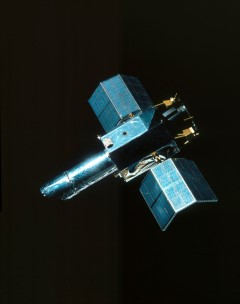Different possible UV spectroscopic missions to follow the OAO series of satellites were being considered by European astronomers and independently by US astronomers starting around 1968. An international team of scientists was eventually formed in 1972 to evaluate the future possible directions in UV astronomy that could be pursued through international collaborations. The eventual outcome of those discussions was a proposal to create the International Ultraviolet Explorer (IUE) satellite to be funded by NASA, the UK Science Research Council, and European Space Research Organization. The key leaders of that effort were Robert Wilson of the UK and Albert Boggess of the US. The IUE that was designed and eventually launched in 1978 contained a 0.45 m primary mirror followed by UV Echelle spectrographs. The UV spectrum was displayed in a compact format on a special TV-type detector known as a secondary electron conducting (SEC) vidicon tube that could record approximately 800 Å of the spectrum in a single exposure. This detector provided a huge multiplexing advantage over the single channel detectors in the OAO satellites. The IUE could obtain complete UV spectra of objects 100 times fainter than faintest objects observed in narrow wavelength regions with the Copernicus satellite. The IUE was launched into a geosynchronous (24 hour) orbit that allowed the satellite to be operated from ground stations in the US and Europe. The IUE revolutionized UV space astronomy because it had the sensitivity to obtain low and high-resolution UV spectra of essentially all classes of astronomical objects.
IUE, 1978-1996, from Comets to Quasars in the Ultraviolet: The IUE was designed for low and high-resolution UV spectroscopy from 1150 to 3200 Å and revolutionized UV spectroscopy during its 18 year life-span from 1978 to 1996. The IUE was situated in a geosynchronous (24 hour) orbit that allowed it to obtain astronomical data 24 hours per day with ground stations in the US at the Goddard Space Flight Center and in Europe. The two dimensional imaging detectors efficiently recorded UV spectra of astronomical sources over a wide wavelength region in a single exposure. The detector background rates were low enough to allow very long integrations of relatively faint objects thereby opening the use of the IUE for a very broad range of scientific investigations. During its lifetime the IUE recorded 104,000 UV spectra of essentially all classes of astronomical objects.
Credit: European Space Agency
IUE High-resolution Spectrum of a Hot Star in the Large Magellanic Cloud: The spectrum of R144 in the Large Magellanic Cloud (LMC), a close-by dwarf galaxy at a distance of 50,000 parsec, shows the UV flux from 1520 to 1578 Å. The narrow absorption lines of Si II (Si+1) and C IV (C+3) reveal the presence of Si II and C IV in the ISM of the Milky Way and the LMC. The LMC is moving away from the Milky Way with a velocity of 270 km per second resulting in a Doppler shift of the LMC absorption to longer wavelengths. The broad absorption between 1540 and 1550 Å is due to the stellar wind of the star R144, the same phenomenon found in the spectrum of the Galactic star ζ Ori by Don Morton. The spectrum provided the first evidence that the Milky Way Galaxy has an extended halo of cooling highly ionized gas. For more information about this spectrum, see Savage, B. D., 2001, "Early Ultraviolet Spectroscopy from Space" in The Century of Space Science, Vol. 1, eds. J. A. M. Bleeker, J. Geiss, M. C. E. Huber, (Kluwer: Dordrecht) p. 287 (Figure 7).
Credit: Image courtesy Blair Savage
I was on the IUE science and instrument development team and was put in charge of the in-flight calibration of the satellite along with Ralph Bohlin. It was a thrilling experience to witness the launch and then a month later to participate in the in-flight check of the instrument. Shortly after the IUE moved into its normal operations phase, I was one of the early guest observers. I pursued with Klaas de Boer several exploratory programs to determine the full capability of the IUE by obtaining low-resolution spectra of two hot stars in the Large Magellanic Cloud (LMC), a nearby dwarf galaxy companion to the Milky Way. The stars were approximately 100 times fainter than the faintest stars the Copernicus satellite could observe. Excellent low-resolution spectra were obtained in only five minutes of exposure. The short exposure time implied that with four- to six-hour long integrations of the same objects it would be possible to obtain high-resolution observations of these distant stars. Later that year, the long exposures were obtained. First, seeing the resulting spectra ranks as the most rewarding observational experience in my life. The spectra clearly revealed very strong interstellar absorption lines from gas in the Milky Way, as well as gas in the LMC, Doppler shifted to longer wavelengths. Of particular significance was the very strong absorption by C+3 in the ISM of both galaxies. The first scientific papers to come from those observations reported on the detection of the highly ionized galactic corona of cooling gas surrounding the Milky Way.
During its 18 year lifetime, the 104,000 spectra obtained by the IUE were used to study the UV properties of very hot and very cool stars, planets, comets, exploding stars, and the nuclei of active galaxies. In my own area of interests, the IUE was extremely valuable in determining the changing nature of UV extinction produced by dust in different interstellar environments and in mapping out the distribution of cooling hot gas in the galactic disk and halo as traced by C+3 and N+4 absorption.



